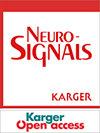SPAK and OSR1 Sensitive Kir2.1 K+ Channels
Q1 Medicine
引用次数: 12
Abstract
Background/Aims: Kir2.1 (KCNJ2) channels are expressed in neurons, skeletal muscle and cardiac tissue and maintain the resting membrane potential. The activity of those channels is regulated by diverse signalling molecules. The present study explored whether Kir2.1 channels are sensitive to the transporter and channels regulating kinases SPAK (SPS1-related proline/alanine-rich kinase) and OSR1 (oxidative stress-responsive kinase 1), which are in turn regulated by WNK (with-no-K[Lys]) kinases. Methods: cRNA encoding Kir2.1 was injected into Xenopus laevis oocytes with or without additional injection of cRNA encoding wild-type SPAK, constitutively active T233ESPAK, WNK insensitive T233ASPAK, catalytically inactive D212ASPAK, wild-type OSR1, constitutively active T185EOSR1, WNK insensitive T185AOSR1 and catalytically inactive D164AOSR1. Inwardly rectifying K+ channel activity was quantified utilizing dual electrode voltage clamp and Kir2.1 channel protein abundance in the cell membrane was measured utilizing chemiluminescence of Kir2.1 containing an extracellular HA-tag epitope. Results: Kir2.1 activity was significantly enhanced by wild-type SPAK and T233ESPAK, but not by T233ASPAK and D212ASPAK, as well as by wild-type OSR1 and T185EOSR1, but not by T185AOSR1 and D164AOSR1. As shown for SPAK, the kinases enhanced Kir2.1 protein abundance in the cell membrane. The difference of current and conductance between oocytes expressing Kir2.1 together with SPAK or OSR1 and oocytes expressing Kir2.1 alone was dissipated following a 24 hours inhibition of channel insertion into the cell membrane by brefeldin A (5 µM). Conclusions: SPAK and OSR1 are both stimulators of Kir2.1 activity. They are presumably effective by enhancing channel insertion into the cell membrane.SPAK和OSR1敏感Kir2.1 K+通道
背景/目的:Kir2.1 (KCNJ2)通道在神经元、骨骼肌和心脏组织中表达,维持静息膜电位。这些通道的活动受到各种信号分子的调节。本研究探讨了Kir2.1通道是否对转运体和通道敏感,这些通道调节激酶SPAK (sps1相关的脯氨酸/富含丙氨酸激酶)和OSR1(氧化应激反应激酶1),而这些激酶又由WNK(含-no- k [Lys])激酶调节。方法:将编码Kir2.1的cRNA分别注射或不注射编码野生型SPAK、组成型活性T233ESPAK、WNK不敏感T233ASPAK、催化失活D212ASPAK、野生型OSR1、组成型活性T185EOSR1、WNK不敏感T185AOSR1和催化失活D164AOSR1的cRNA。利用双电极电压钳定量内整流K+通道活性,利用含有细胞外ha标签表位的Kir2.1的化学发光测量细胞膜上Kir2.1通道蛋白的丰度。结果:野生型SPAK和T233ESPAK显著增强Kir2.1活性,T233ASPAK和D212ASPAK显著增强Kir2.1活性,野生型OSR1和T185EOSR1显著增强Kir2.1活性,T185AOSR1和D164AOSR1显著增强Kir2.1活性。如SPAK所示,这些激酶增加了细胞膜中Kir2.1蛋白的丰度。在brefeldin a(5µM)抑制通道插入细胞膜24小时后,表达Kir2.1和SPAK或OSR1的卵母细胞与单独表达Kir2.1的卵母细胞之间的电流和电导差异消失。结论:SPAK和OSR1都是Kir2.1活性的刺激因子。它们可能是通过增强通道插入细胞膜而有效的。
本文章由计算机程序翻译,如有差异,请以英文原文为准。
求助全文
约1分钟内获得全文
求助全文
来源期刊

Neurosignals
医学-神经科学
CiteScore
3.40
自引率
0.00%
发文量
3
审稿时长
>12 weeks
期刊介绍:
Neurosignals is an international journal dedicated to publishing original articles and reviews in the field of neuronal communication. Novel findings related to signaling molecules, channels and transporters, pathways and networks that are associated with development and function of the nervous system are welcome. The scope of the journal includes genetics, molecular biology, bioinformatics, (patho)physiology, (patho)biochemistry, pharmacology & toxicology, imaging and clinical neurology & psychiatry. Reported observations should significantly advance our understanding of neuronal signaling in health & disease and be presented in a format applicable to an interdisciplinary readership.
 求助内容:
求助内容: 应助结果提醒方式:
应助结果提醒方式:


